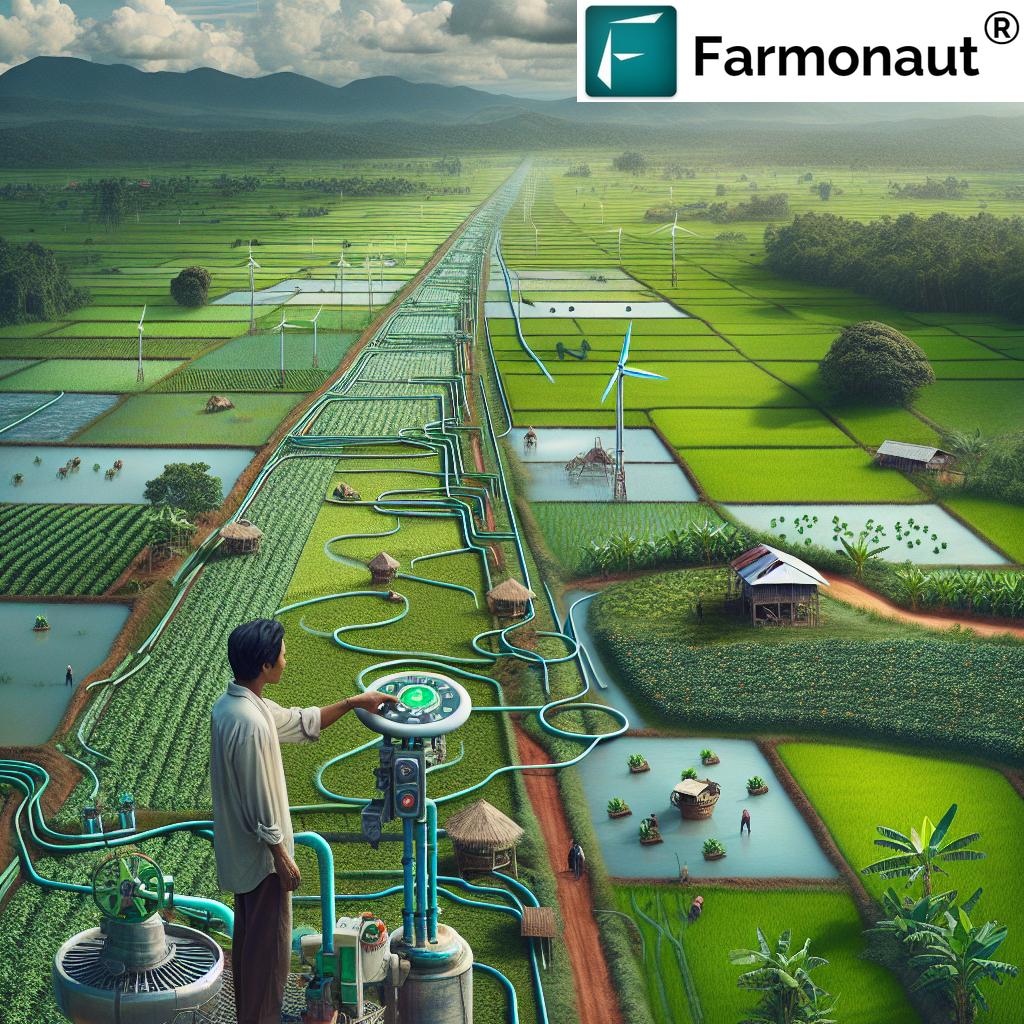Vietnam’s Economic Transformation: Navigating Corruption, Innovation, and the Fourth Industrial Revolution
“Vietnam’s corruption perception index ranking improved by 30 positions between 2011 and 2021, showcasing significant progress in governance.”
In the dynamic landscape of Southeast Asia, Vietnam has emerged as a beacon of economic growth and technological innovation. As we delve into the intricate tapestry of Vietnam’s journey towards becoming a global powerhouse, we’ll explore the challenges, triumphs, and strategies that have shaped its remarkable transformation. From combating corruption to embracing the Fourth Industrial Revolution, Vietnam’s story is one of resilience, ambition, and forward-thinking leadership.
The Rise of Vietnam: A Testament to Economic Resilience
Vietnam’s economic growth story is nothing short of impressive. Over the past decade, the country has consistently outperformed many of its regional peers, maintaining an average growth rate of 5.5% from 2011 to 2023. This remarkable feat, achieved despite the global disruptions caused by the COVID-19 pandemic, speaks volumes about Vietnam’s economic resilience and the effectiveness of its policies.
At the heart of this success lies the visionary leadership of the Communist Party of Vietnam (CPV), particularly under the guidance of the late General Secretary Nguyen Phu Trong. His tenure marked a significant turning point in Vietnam’s fight against corruption, a battle that has yielded tangible results on the global stage.

Tackling Corruption: A Cornerstone of Vietnam’s Progress
One of the most significant indicators of Vietnam’s progress has been its steady climb in Transparency International’s Corruption Perceptions Index. In 2011, Vietnam scored a mere 2.9 out of 100, ranking 112th among 180 countries. Fast forward to 2023, and the country had dramatically improved its score to 41, elevating its position to 83rd globally. This leap of 29 places is a testament to the effectiveness of Vietnam’s anti-corruption measures and its commitment to good governance.
The impact of this improvement cannot be overstated. A more transparent business environment has not only boosted domestic confidence but has also made Vietnam an increasingly attractive destination for foreign investment. As we navigate the complexities of global supply chains and seek reliable partners in high-tech production, Vietnam’s enhanced reputation for integrity positions it favorably on the world stage.
Embracing the Fourth Industrial Revolution
While the fight against corruption has been crucial, it is just one piece of the puzzle in Vietnam’s broader strategy for development. As we stand on the cusp of the Fourth Industrial Revolution, Vietnam recognizes that modernizing its state apparatus and embracing technological innovation are paramount to its continued success.
The Fourth Industrial Revolution, characterized by the fusion of digital, biological, and physical innovations, presents both challenges and opportunities for developing nations like Vietnam. To fully leverage these opportunities, Vietnam is focusing on key areas such as:
- Digitization of government services and industries
- Integration of artificial intelligence in various sectors
- Exploration of quantum computing applications
- Development of smart cities and infrastructure
These initiatives are not just about keeping pace with global trends; they’re about positioning Vietnam as a leader in technological innovation within Southeast Asia and beyond.
Transitioning to Technology-Intensive Production
As Vietnam sets its sights on becoming a high-income country by 2045, there’s a growing recognition that the current labor-intensive manufacturing model may not be sufficient to sustain long-term growth. The shift towards technology-intensive production is not just desirable; it’s essential for Vietnam to avoid the middle-income trap and continue its upward trajectory.
This transition involves several key strategies:
- Upskilling the workforce: Investing in education and training programs to create a technologically savvy labor force.
- Attracting high-tech foreign investment: Creating incentives and improving infrastructure to appeal to companies in cutting-edge industries.
- Fostering domestic innovation: Supporting local startups and research institutions to drive homegrown technological advancements.
- Developing integrated value chains: Building robust domestic supply chains that can support high-tech manufacturing.
By focusing on these areas, Vietnam aims to position itself as a key player in the global supply chain for high-tech products, from computer chips to electric vehicles and beyond.
Vietnam’s 2030 Development Goals: A Roadmap to Success
Vietnam’s ambitions are crystallized in its 2030 development goals, which serve as a roadmap for the country’s continued growth and transformation. These goals are aligned with the global Sustainable Development Goals (SDGs) and reflect Vietnam’s commitment to balanced, inclusive, and sustainable development.
Key targets include:
- Achieving upper-middle-income status
- Increasing the contribution of the digital economy to GDP
- Enhancing environmental sustainability and low-carbon production
- Improving social welfare and reducing inequality
To achieve these ambitious targets, Vietnam is leveraging technology and innovation across various sectors. For instance, in agriculture, platforms like Farmonaut are revolutionizing farming practices with satellite-based crop monitoring and AI-driven advisory systems. Such technologies not only boost productivity but also promote sustainable resource management, aligning perfectly with Vietnam’s development goals.

Overcoming Challenges: Bureaucracy and Beyond
Despite its impressive progress, Vietnam faces several hurdles in its path to becoming a technological powerhouse. One of the most significant challenges is bureaucratic inertia. The transition from a centrally planned economy to a more market-oriented one requires not just policy changes but a shift in mindset at all levels of government.
Key challenges include:
- Streamlining administrative procedures to facilitate business operations
- Reforming state-owned enterprises to enhance efficiency and competitiveness
- Improving transparency and accountability in public institutions
- Balancing rapid development with environmental sustainability
Addressing these challenges requires a multifaceted approach, combining policy reforms, technological solutions, and capacity building. Vietnam’s success in navigating these complexities will be crucial in determining its future trajectory on the global stage.
The Role of Foreign Investment in Vietnam’s Technological Leap
Foreign investment plays a pivotal role in Vietnam’s technological advancement. As the country positions itself as a reliable alternative in global supply chains, it’s attracting increased attention from international tech giants and innovative startups alike. This influx of foreign capital and expertise is crucial for:
- Technology transfer and knowledge sharing
- Upgrading infrastructure and production capabilities
- Creating high-skilled job opportunities
- Integrating Vietnam into global innovation networks
To capitalize on this opportunity, Vietnam is continuously improving its business environment, offering incentives for high-tech investments, and developing specialized economic zones focused on innovation and technology.
“Vietnam aims to become a high-income country by 2045, with a per capita GDP target of $18,000.”
Sustainable Development: Balancing Growth and Environmental Stewardship
As Vietnam races towards its economic goals, there’s a growing emphasis on sustainable development and low-carbon production practices. This focus is not just about environmental responsibility; it’s a strategic move to enhance Vietnam’s competitiveness in a world increasingly concerned with sustainability.
Key initiatives in this area include:
- Promoting renewable energy sources and clean technologies
- Implementing circular economy principles in manufacturing
- Developing green urban infrastructure and smart cities
- Encouraging sustainable agricultural practices through tech adoption
Platforms like Farmonaut play a crucial role in this transition, offering farmers tools to optimize resource use and reduce environmental impact. By leveraging satellite imagery and AI, such technologies enable precision agriculture, contributing to both productivity and sustainability goals.
Vietnam in the Global Supply Chain: Positioning for High-Tech Production
As global supply chains undergo restructuring, Vietnam is strategically positioning itself as a reliable hub for high-tech production. This ambition goes beyond mere assembly; Vietnam aims to become an integral part of the value chain for advanced technologies. To achieve this, the country is:
- Investing in research and development facilities
- Cultivating partnerships with global tech leaders
- Developing specialized industrial parks for high-tech manufacturing
- Enhancing intellectual property protections to attract innovation
The success of this strategy will not only boost Vietnam’s economic growth but also elevate its status in the global technological landscape.
The Path Forward: Navigating Challenges and Opportunities
As Vietnam continues its remarkable journey of economic transformation, it faces a complex landscape of challenges and opportunities. The country’s ability to navigate these waters will determine its success in achieving its ambitious goals for 2030 and beyond.
Key areas of focus for the future include:
- Continued investment in education and skills development
- Further streamlining of bureaucratic processes to enhance efficiency
- Deepening regional and global economic integration
- Balancing rapid technological adoption with social inclusivity
- Strengthening cybersecurity and digital governance frameworks
By addressing these areas, Vietnam can solidify its position as a rising star in the global economy and a leader in technological innovation within Southeast Asia.
Vietnam’s Economic Transformation Milestones
| Year | Milestone | Impact |
|---|---|---|
| 2011 | Vietnam scores 2.9 on Corruption Perceptions Index | Baseline for anti-corruption efforts |
| 2016 | Launch of national strategy on Fourth Industrial Revolution | Set direction for technological advancement |
| 2020 | Implementation of EU-Vietnam Free Trade Agreement | Enhanced access to European markets |
| 2023 | Vietnam scores 41 on Corruption Perceptions Index | Significant improvement in governance perception |
| 2025 (Projected) | Targeted 20% contribution of digital economy to GDP | Accelerated digital transformation across sectors |
| 2030 (Goal) | Aim to achieve upper-middle-income status | Milestone in economic development journey |
Conclusion: Vietnam’s Promising Future
Vietnam’s journey from a war-torn nation to an emerging economic powerhouse is a testament to the resilience and vision of its people and leadership. As the country navigates the complexities of the Fourth Industrial Revolution, combats corruption, and positions itself as a key player in the global high-tech supply chain, it stands on the brink of a new era of prosperity and innovation.
The challenges ahead are significant, but so are the opportunities. By continuing to invest in education, embrace technological innovation, and maintain its commitment to sustainable development, Vietnam is well-positioned to achieve its ambitious goals for 2030 and beyond. As we watch Vietnam’s continued transformation, one thing is clear: the country’s rise as a technological and economic leader in Southeast Asia is not just possible—it’s probable.
For those looking to be part of Vietnam’s exciting journey, platforms like Farmonaut offer innovative solutions that align with the country’s goals of technological advancement and sustainable development. Whether you’re a farmer looking to optimize your operations or an investor seeking opportunities in Vietnam’s burgeoning tech sector, the time to engage is now.
Earn With Farmonaut: Join our affiliate program and earn 20% recurring commission by sharing your promo code and helping farmers save 10%. Onboard 10 Elite farmers monthly to earn a minimum of $148,000 annually—start now and grow your income!
FAQ: Vietnam’s Economic Transformation
- Q: What is the Fourth Industrial Revolution, and how is Vietnam adapting to it?
A: The Fourth Industrial Revolution refers to the fusion of digital, biological, and physical technologies. Vietnam is adapting by investing in digitization, AI, quantum computing, and smart city development. - Q: How has Vietnam improved its standing in the Corruption Perceptions Index?
A: Vietnam has implemented strict anti-corruption measures, improved transparency in governance, and reformed public institutions, resulting in a significant improvement from a score of 2.9 in 2011 to 41 in 2023. - Q: What are Vietnam’s key economic goals for 2030?
A: Vietnam aims to achieve upper-middle-income status, increase the digital economy’s contribution to GDP, enhance environmental sustainability, and improve social welfare. - Q: How is Vietnam positioning itself in the global high-tech supply chain?
A: Vietnam is attracting foreign investment in high-tech industries, developing specialized economic zones, and investing in research and development to become a reliable hub for advanced technology production. - Q: What role does sustainable development play in Vietnam’s economic strategy?
A: Sustainable development is crucial to Vietnam’s strategy, focusing on renewable energy, circular economy principles, and green urban infrastructure to enhance long-term competitiveness and environmental stewardship.
















